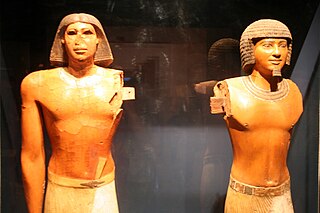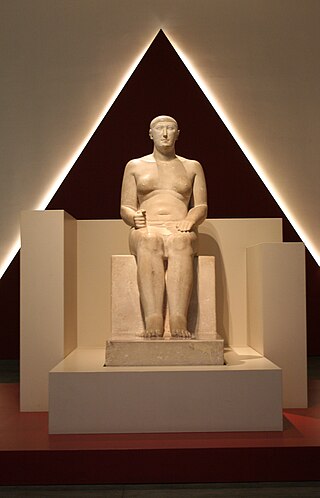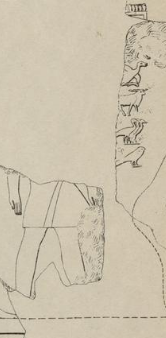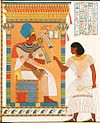Related Research Articles

Pepi I Meryre was an ancient Egyptian pharaoh, third king of the Sixth Dynasty of Egypt, who ruled for over 40 years at the turn of the 24th and 23rd centuries BC, toward the end of the Old Kingdom period. He was the son of Teti, the founder of the dynasty, and ascended the throne only after the brief intervening reign of the shadowy Userkare. His mother was Iput, who may have been a daughter of Unas, the final ruler of the preceding Fifth Dynasty. Pepi I, who had at least six consorts, was succeeded by his son Merenre Nemtyemsaf I, with whom he may have shared power in a coregency at the very end of his reign. Pepi II Neferkare, who might also have been Pepi I's son, succeeded Merenre.

Ptahhotep, sometimes known as Ptahhotep I or Ptahhotpe, was an ancient Egyptian vizier during the late 25th century BC and early 24th century BC Fifth Dynasty of Egypt.

The vizier was the highest official in ancient Egypt to serve the pharaoh (king) during the Old, Middle, and New Kingdoms. Vizier is the generally accepted rendering of ancient Egyptian tjati, tjaty etc., among Egyptologists. The Instruction of Rekhmire, a New Kingdom text, defines many of the duties of the tjaty, and lays down codes of behavior. The viziers were often appointed by the pharaoh. During the 4th Dynasty and early 5th Dynasty, viziers were exclusively drawn from the royal family; from the period around the reign of Neferirkare Kakai onwards, they were chosen according to loyalty and talent or inherited the position from their fathers.

Rashepses was a vizier from the Fifth Dynasty of Egypt. Rashepses was vizier under Djedkare Isesi. A letter directed to Rashepses has been preserved. This decree is inscribed in his tomb in Saqqara. As vizier he was one of the most important Ancient Egyptian officials. In his tomb are many titles recorded. It seems that he was first overseer of the scribes of the royal documents, overseer of the two granaries and overseer of all royal works. These are all very important titles, making him an influential official at the royal court. At the final stage of his career he became vizier. The vizier title is only preserved in two letters that are copied on the decoration of the tomb. It seems that most of his tomb was finished and after all that, he was promoted.

The high steward was an important official at the royal court in Ancient Egypt in the Middle Kingdom and in the New Kingdom. He was the main person in charge of the estates supplying the palace and the royal residence with food. The office appears in the 11th Dynasty. To the earliest title holders belong Henenu and Meketre. After the vizier and the treasurer this was the most important office at the royal court; important title holders of the 12th Dynasty were Siese and Khnumhotep III, both were later in their career appointed vizier.
The overseer of the treasuries was an important official at the ancient Egyptian court of the Old and the New Kingdom. The title is first attested in the Fourth Dynasty. The title is not common in the Middle Kingdom, but is in the New Kingdom one of the most important ones at the royal court. The treasury was the place in the royal palace where precious materials were stored, such as metal objects, but also linen. Therefore, the overseer of the treasuries was basically responsible for administrating the resources of the country. The title is also attested in the Late Period. The writing of the title varies between ""overseer of the treasury" and "overseer of the two treasuries". It is not always clear whether this relates to different functions.
Mehu was an Ancient Egyptian vizier who lived in the Sixth Dynasty, around 2300 BC. The office of the vizier was the most important one at the royal court. Mehu is mainly known from his monumental mastaba at Saqqara, not far away from the Pyramid of Unas.
Ptahhotep Desher was an Ancient Egyptian official at the end of the Fifth Dynasty, most likely in office under kings Menkauhor Kaiu and Djedkare Isesi. His main function was that of a vizier. This was the most important office in Ancient Egypt, second only to the king. Ptahhotep also held other titles, such as overseer of the six great houses, overseer of the scribes of the royal documents and overseer of all royal works. These are all important functions, often held by a vizier.
Kay was an Ancient Egyptian official living most likely in the Fifth Dynasty. He is mainly known from his mastaba in Saqqara North. Kay hold a high number of important titles making him the most powerful of his time, only second to the king. His main office was that of a vizier. Beside being vizier, he was also holding many other important titles, such as Overseer of the treasuries, Overseer of Upper Egypt, overseer of the scribes of the king's document, overseer of the six big houses and overseer of all royal works of the king. His mastaba in Saqqara was recorded by Gaston Maspero who assigned to it the number D 19. Kay was bearing 51 titles, making him the vizier with the highest numbers of titles. Kay was the first Egyptian official with the title overseer of the six big houses. The office became one of the most important at the royal court in the later Fifth Dynasty and continued to be so during the subsequent Sixth Dynasty.
Washptah, with the second name Izi, was an ancient Egyptian official in the Fifth Dynasty under king Neferirkare Kakai. His most important title was that of a vizier, making him to the most important official at the royal court, only second to the king. Next to the office of the vizier he hold several other important positions, including overseer of the scribes of the king's document and overseer of all royal works.
Seshathetep, also called Heti, was an ancient Egyptian official at the beginning of the Fifth Dynasty. Seshathetep held many important titles, possibly including that of vizier. With this latter title, he would have been the most important official at the royal court, second only to the king. He also bore the title of king's son of his body, yet it is doubtful that Seshathetep was the real son of a king.

Werbauba was an Ancient Egyptian official of the Fifth Dynasty during the reign of pharaoh Sahure. He had the titles of a vizier and was therefore the highest official at the royal court, second only to the king. Werbauba is only known from the reliefs found in the mortuary temple of king Sahure at Abusir. In a relief, he is shown behind the king, the first in a row of officials. The whole scene is a representation of a royal hunt, which is now heavily damaged. Werbauba is depicted in the lowest register as the first person. Only his name and three titles are preserved: the one of the curtain, official (z3b) and vizier. This title combination is typical for an Old Kingdom vizier. It has been argued that this part of the temple was finished at the end of the king's reign, so that Werbauba was in office at the end of Sahure's life and perhaps even beyond, into the reign of Neferirkare Kakai.
Ptahhotep was an ancient Egyptian official of the Fifth Dynasty, most likely under king Djedkare Isesi. His most important office was that of a vizier, making him to the most important official at the royal court, only second to the king. Next to this important office he held further important titles, such as overseer of the treasuries, overseer of the scribes of the king's document, overseer of the six big houses and overseer of all royal works of the king.
Akhethetep Hemi was an ancient Egyptian official at the end of the Fifth Dynasty, most likely in office under king Unas. His highest title was that of a vizier, making him to the most important official at the royal court, only second to the king. Next to the vizier's titles he was also overseer of the treasuries, overseer of the scribes of the king's document and overseer of the double granary, all these are important position at the royal court.
Ihy was an Ancient Egyptian official of the Fifth Dynasty, in office most likely under king Unas. Ihy was vizier and was therefore the most important official at the royal court only second to the king. Next to the titles of a vizier, he was also overseer of the treasuries, overseer of the scribes of the king's document, overseer of all royal works and overseer of the double granary. These are also important titles, demonstrating his important position at the royal court.
Niankhba was an ancient Egyptian official from the end of the Fifth Dynasty, in office under king Unas. Niankhba was vizier and was therefore the most important official at the royal court. Niankhba is known from his mastaba next to the pyramid of king Unas. The mastaba was found heavily destroyed. His name and titles are only known from the inscriptions found in the burial chamber. The walls of the burial chamber were decorated. The sarcophagus in the burial chamber was inscribed.
Sobeknakht I was an ancient Egyptian official of the Second Intermediate Period. He was local governor at Elkab.
Dedusobek Bebi was a high official of the late Thirteenth Dynasty of ancient Egypt. He became the "Great Scribe of the Vizier". This position was directly under the Vizier acting as a deputy.
The royal sealer or royal seal-bearer was an Ancient Egyptian official position and title. The name literally means "sealer of the king of Lower Egypt," but it seems unlikely that the position was ever geographically limited. In the Early Dynastic period and Old Kingdom, it was one of the most important positions in Egypt. The bearer seems to have headed the treasury and had significant symbolic power as an official representative of the Pharaoh. As a "ranking title," it indicated the bearer's pre-eminence in court. In the late Middle Kingdom, it was revived as a ranking title borne by many of the highest officials in the court. This apparently coincided with an increased prominence of seals in the Egyptian administration, as part of a centralisation of the bureaucracy. The title spread more widely in the Second Intermediate period, diluting its power.
The Overseer of cattle was an Ancient Egyptian official position, during the New Kingdom.
References
- ↑ Juan Carlos Moreno García: The territorial Administration of the Kingdom, in: Juan Carlos Moreno Gracía (editor): Ancient Egyptian Administration, Leiden, Boston 2013, p. 118-119
